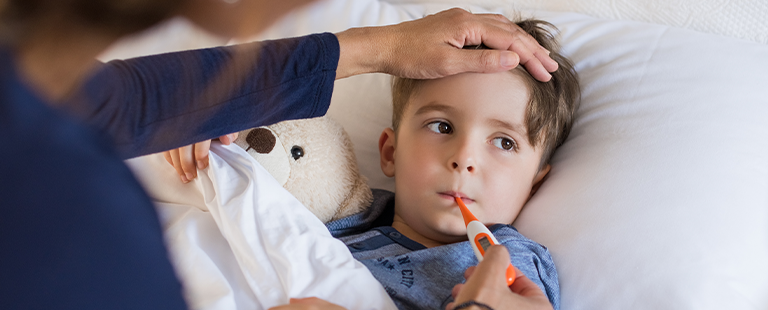KIDS + COLD & FLU
Coughs, colds, and the flu in children – causes, prevention + support.
Cold and flu are the most commonly experienced illnesses in Australia. Children and infants are affected more often and tend to experience more prolonged symptoms than adults.
Colds are more common during the autumn and winter months when the weather is cooler, and many children spend a lot of time indoors together in groups at school or kindergarten.
Some young children under two years old may catch as many as eight to ten colds per year and it can seem as though they remain sick continuously all winter long.
The common cold
The common cold is caused by a group of more than one hundred viruses known as rhinoviruses which infect the upper respiratory system including the nose, throat and the sinuses.
Adults are affected by colds less frequently than children as they have had more opportunity over the years to build immunity to the different cold-causing viruses.
When a cold virus manages to penetrate the protective lining of the nose or throat, it will usually trigger an immune system response which includes a range of symptoms.
Symptoms:
- Nasal congestion and a runny nose
- Blocked sinuses
- Sneezing
- Sore throat
- Coughing
- Tiredness
- Mild fever
The flu
‘The flu’ is an infection caused by a strain of the influenza virus. It predominantly affects the nose, throat, and sinuses, but can also affect the lungs and other parts of the body.
Most children, as well as adults, catch the flu far less frequently than the common cold, although symptoms can be more serious and can last for longer. Otherwise healthy children generally experience a case of the flu similarly to a bad cold.
Most cases of the flu occur during autumn and winter. Slightly different strains of the virus are spread each year during cold and flu season and occasionally certain strains can cause more serious or widespread outbreaks.
Symptoms:
- Coughing
- Difficulty breathing
- Aches and pains
- Fever
- Nasal congestion and a runny nose
- Blocked sinuses
- Sore throat
- Nausea and vomiting
- Tiredness/ low energy
- Diarrhoea
Prevention
Cold and flu viruses are highly transmissible. They are spread by person-to-person contact, or by breathing in virus particles, which can spread up to four metres when a person coughs or sneezes.
Sick children spread viruses when they touch their runny noses or mouths when they cough or sneeze, and then go on to touch other children or objects. Cold viruses are particularly contagious for the first two to four days after symptoms are first noticed.
In order to avoid catching colds frequently, kids should:
- Keep their distance from anyone who has a cold
- Wash their hands frequently, particularly after blowing their noses
- Sneeze or cough into a tissue or their elbow, not into their hands
- Do not share drinks, food, eating utensils or towels with anyone who currently has a cold
Support
There is no ‘cure’ for cold or flu and generally once someone is sick, the virus needs to run its course.
Taking supplements including vitamin C, zinc and elderberry may help to limit how bad cold symptoms get or how long they last.
It’s a good idea to ensure kids stay well hydrated by drinking plenty of water, do not exert themselves and get plenty of sleep in order to give their body’s the best chance of fighting off the virus and getting healthy again as quickly as possible.
Putting saline drops in the nostrils may help to relieve nasal congestion. Running a cool mist humidifier, or alternatively running a hot shower to create a steam-filled bathroom where your child can sit can help to relieve stuffiness, nasal and sinus congestion.
Soaking in a warm bath or using a hot water bottle or heating pad may help soothe aches and pains.
When to see a doctor?
While most colds are relatively minor and otherwise healthy children and adults generally recover well at home after a few days.
It’s a good idea to seek medical advice if you believe your child may have a more serious infection, if symptoms are getting worse after the first few days or if the following symptoms are experienced:
- Coughing up large amounts of mucus
- Shortness of breath
- Headache that is getting worse
- Earache
- Throat or facial pain that is getting worse
- Inability to keep food or drink down
- Painful sore throat
- Difficulty swallowing
- Fever of 39°C or 39°C that lasts for more than a day
- Chest pain
- Stomach pain
- Swollen lymph glands in the neck
Sambucol Kids Cold & Flu products
Sambucol Kids Cough Liquid
Sambucol Kids Soothing Throat Pops
Sambucol Kids Immune Defence Gummies
Sambucol Black Elderberry Cold & Flu Relief Kids


